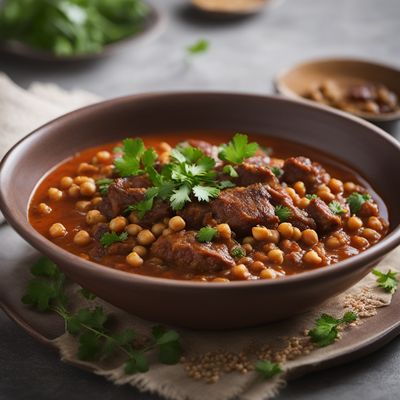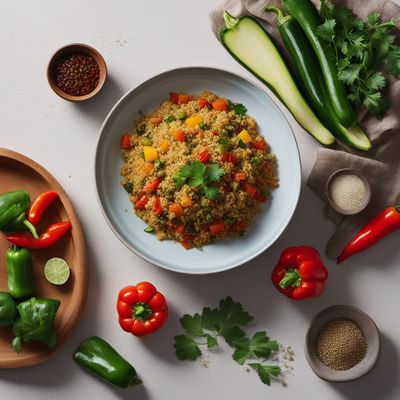
Recipe
Pakistani Chinese Hafechabis
Spicy Fusion Delight: Pakistani Chinese Hafechabis
4.5 out of 5
Indulge in the flavors of Pakistani Chinese cuisine with this unique twist on the traditional Tunisian dish, Hafechabis. This fusion recipe combines the aromatic spices and bold flavors of Pakistani and Chinese cuisines, resulting in a mouthwatering dish that will leave you craving for more.
Metadata
Preparation time
20 minutes
Cooking time
15 minutes
Total time
35 minutes
Yields
4 servings
Preparation difficulty
Easy
Suitable for
Non-vegetarian, Gluten-free, Dairy-free, Low-carb, High-protein
Allergens
Soy
Not suitable for
Vegetarian, Vegan, Paleo, Keto, Nut-free
Ingredients
In the original Tunisian Hafechabis, the chicken is typically marinated in Tunisian spices and cooked with tomatoes and chickpeas. However, in this Pakistani Chinese adaptation, we use a blend of Pakistani spices and stir-fry the chicken with a variety of vegetables in a tangy Chinese sauce. This fusion dish combines the bold flavors of Pakistani cuisine with the vibrant and spicy elements of Chinese cuisine, resulting in a unique and delicious twist on the traditional Hafechabis. We alse have the original recipe for Hafechabis, so you can check it out.
-
500g (1.1 lb) boneless chicken, cut into bite-sized pieces 500g (1.1 lb) boneless chicken, cut into bite-sized pieces
-
2 tablespoons vegetable oil 2 tablespoons vegetable oil
-
1 onion, thinly sliced 1 onion, thinly sliced
-
1 red bell pepper, thinly sliced 1 red bell pepper, thinly sliced
-
1 green bell pepper, thinly sliced 1 green bell pepper, thinly sliced
-
1 carrot, julienned 1 carrot, julienned
-
3 cloves garlic, minced 3 cloves garlic, minced
-
1 tablespoon ginger, grated 1 tablespoon ginger, grated
-
2 tablespoons soy sauce 2 tablespoons soy sauce
-
1 tablespoon chili sauce 1 tablespoon chili sauce
-
1 tablespoon tomato ketchup 1 tablespoon tomato ketchup
-
1 teaspoon cumin powder 1 teaspoon cumin powder
-
1 teaspoon coriander powder 1 teaspoon coriander powder
-
1/2 teaspoon turmeric powder 1/2 teaspoon turmeric powder
-
Salt, to taste Salt, to taste
-
Fresh cilantro, for garnish Fresh cilantro, for garnish
Nutrition
- Calories (kcal / KJ): 320 kcal / 1340 KJ
- Fat (total, saturated): 12g, 2g
- Carbohydrates (total, sugars): 15g, 6g
- Protein: 35g
- Fiber: 4g
- Salt: 2g
Preparation
-
1.In a bowl, combine the chicken, cumin powder, coriander powder, turmeric powder, and salt. Mix well and let it marinate for 30 minutes.
-
2.Heat oil in a wok or large skillet over medium-high heat. Add the marinated chicken and cook until browned and cooked through. Remove the chicken from the wok and set aside.
-
3.In the same wok, add the sliced onion and cook until translucent. Add the minced garlic and grated ginger, and cook for another minute.
-
4.Add the sliced bell peppers and julienned carrot to the wok. Stir-fry for a few minutes until the vegetables are slightly tender.
-
5.In a small bowl, whisk together soy sauce, chili sauce, and tomato ketchup. Pour the sauce mixture into the wok and stir well to coat the vegetables.
-
6.Return the cooked chicken to the wok and toss everything together until the chicken and vegetables are evenly coated with the sauce.
-
7.Cook for an additional 2-3 minutes, allowing the flavors to meld together.
-
8.Garnish with fresh cilantro and serve hot with steamed rice or noodles.
Treat your ingredients with care...
- Chicken — Make sure to cut the chicken into bite-sized pieces to ensure even cooking.
- Ginger — Use fresh ginger for the best flavor. Grate it finely to incorporate it well into the dish.
- Soy sauce — Opt for low-sodium soy sauce if you prefer to control the saltiness of the dish.
- Chili sauce — Adjust the amount of chili sauce according to your spice preference.
- Fresh cilantro — Rinse the cilantro thoroughly and chop it just before garnishing to maintain its freshness.
Tips & Tricks
- For an extra kick of heat, add a few chopped green chilies to the dish.
- Customize the vegetable selection based on your preference. You can add mushrooms, snow peas, or baby corn for additional variety.
- If you prefer a saucier dish, double the amount of sauce ingredients.
- To make it more authentic, garnish with thinly sliced green onions and sesame seeds.
- Experiment with different types of chili sauces to find your favorite flavor profile.
Serving advice
Serve the Pakistani Chinese Hafechabis hot with steamed rice or noodles. Garnish with fresh cilantro for added freshness and color.
Presentation advice
For an appealing presentation, arrange the colorful stir-fried vegetables and chicken on a bed of steamed rice or noodles. Garnish with a sprig of fresh cilantro and serve in a vibrant serving dish.
More recipes...
More Tunisian cuisine dishes » Browse all

Assidat zgougou
Assidat zgougou is a traditional Tunisian dessert that is perfect for any occasion. It is a delicious combination of almond milk, semolina, and...

Makroud el louse
Makroud el louse is a traditional Algerian pastry that is made with semolina flour and dates. It is a sweet and sticky pastry that is often served...

Bambalouni
Bambalouni is a popular Tunisian street food that is similar to a doughnut. It is a fried dough ball that is crispy on the outside and soft on the...









